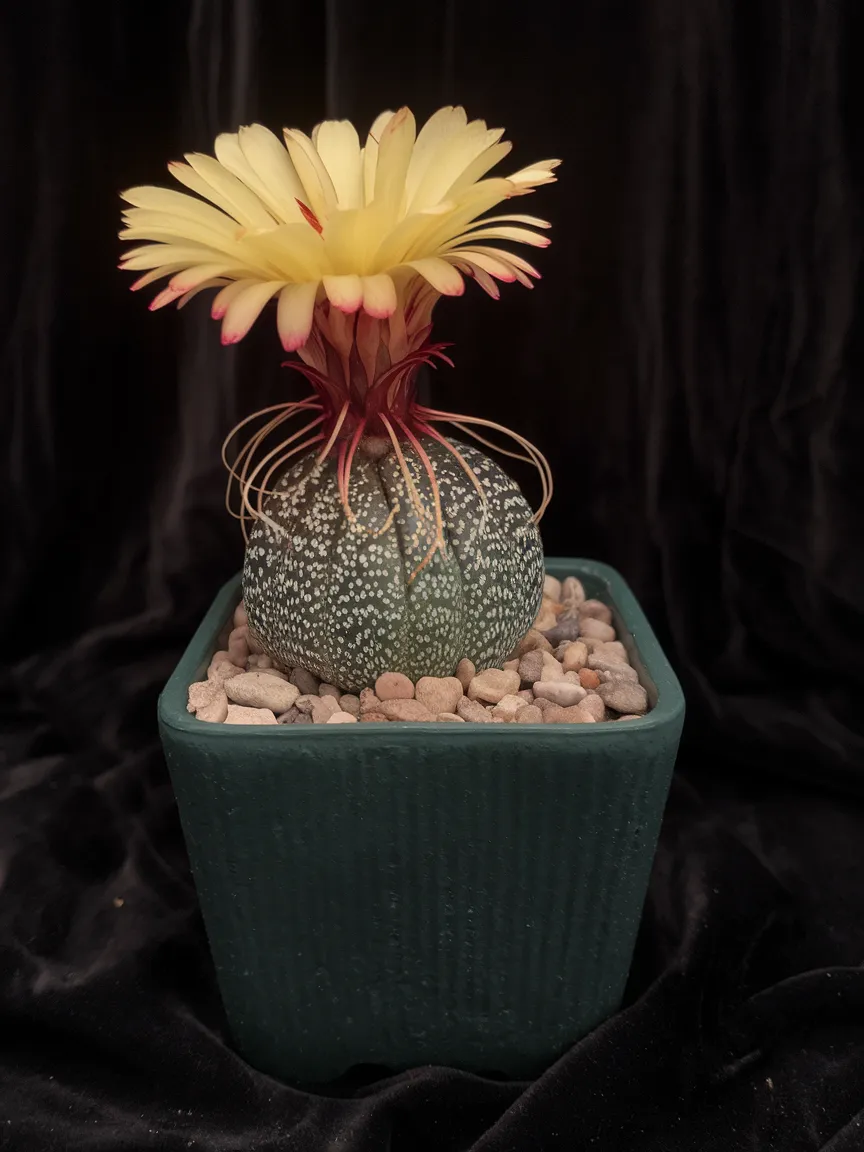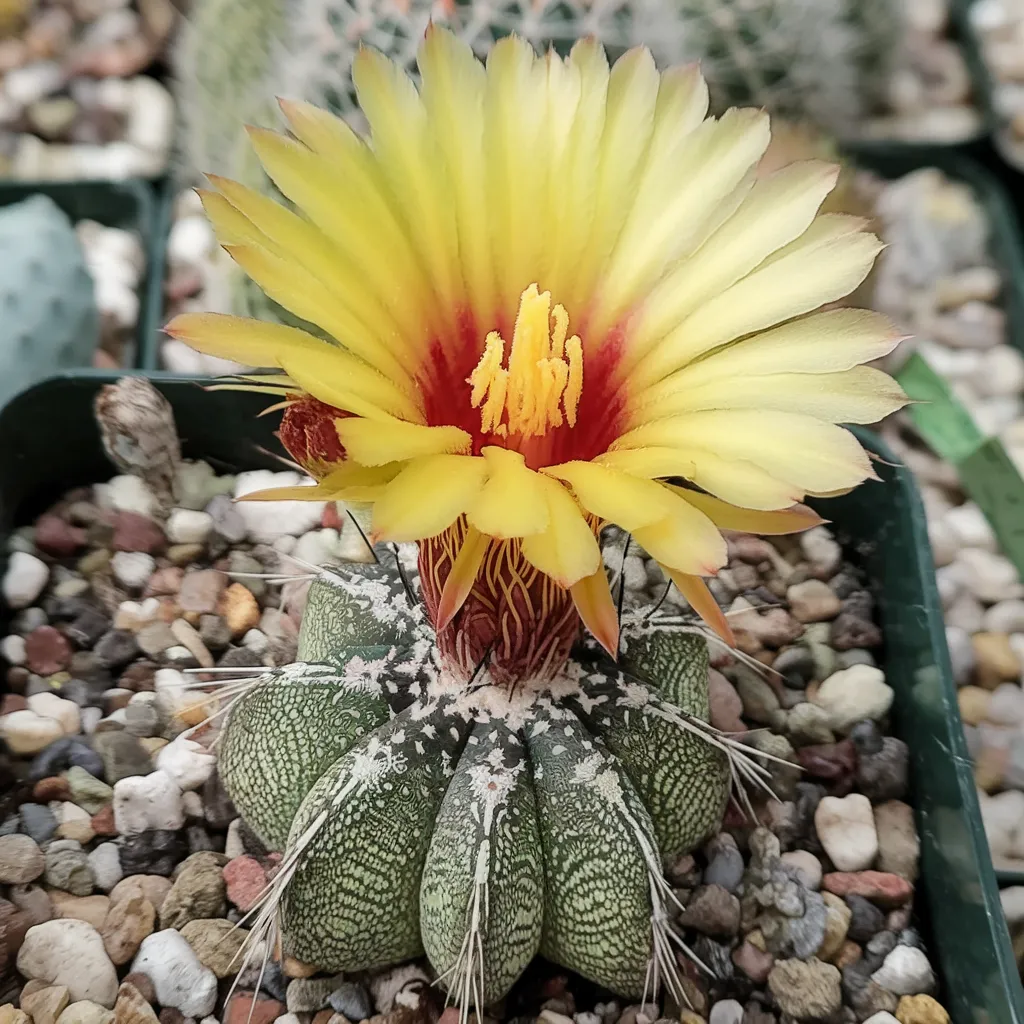Biological Features of Astrophytum Capricorne
Astrophytum Capricorne, commonly known as the Cow Skull Cactus, has unique biological features that set it apart from other cacti. This species generally exhibits a cylindrical shape, typically reaching up to 30 cm in height. Its spine arrangement creates an impressive artistic appearance, where tufts of white wool emerge at the apex. Furthermore, its body color often varies from green to a bluish hue, adding to its visual appeal.
Adaptations and Growth Conditions
Astrophytum Capricorne adapts well to arid environments. It requires minimal water and thrives in well-drained soils. In its natural habitat, it grows at a higher elevation, which means it can tolerate cooler temperatures. Additionally, the plant displays a fascinating behavior during dry periods: it can enter a state of dormancy to conserve water
For optimum growth, consider the following conditions:
| Condition | Optimal Level |
|---|---|
| Sunlight | Full sun |
| Soil Type | Well-draining cactus mix |
| Watering Frequency | Every 2-3 weeks during summer |
| Temperature | 18-30°C (65-85°F) |
Moreover, Astrophytum Capricorne produces stunning yellow flowers, appearing in late spring or early summer. These flowers emerge from the plants’ tops, attracting pollinators, which is crucial for its reproduction. Overall, the unique adaptations and striking appearance contribute to the allure of Astrophytum Capricorne in both gardens and collections.

History and Cultural Significance
Astrophytum Capricorne, often called the Capricorn cactus, has a rich history in both botany and culture. Originating from Mexico, this unique cactus has captivated the attention of enthusiasts and collectors since its discovery. Its distinctive appearance features distinctive patterns and spines that resemble a star or a horn, making it a popular choice for decorative arrangements.
The Significance in Culture
In Mexican culture, this cactus is associated with resilience and adaptability. It thrives in harsh environments, symbolizing endurance in the face of adversity. Furthermore, it has become a part of folklore, often representing strength and harmony with nature.
Collectors appreciate Astrophytum Capricorne for its rarity and beauty. Specifically, this plant’s cultivation requires special care, creating a sense of achievement for gardeners. Its unique physical traits foster a deeper interest in its origin and conservation.
Uses in Traditional Practices
This cactus is not simply ornamental. In some regions, it has been used in traditional medicine. Although research is limited, it has been used in practices believed to promote health and well-being.
Interesting Facts
- Astrophytum Capricorne is often found in dry, rocky environments.
- It can live for many decades, sometimes even reaching a century.
- The cactus has various cultivars, some with stunning mutations.
- It is a popular species for grafting, creating hybrid plants.
The popularity of this cactus continues to grow, fueled by its fascinating history and cultural significance. In summary, Astrophytum Capricorne stands as a testament to both nature’s beauty and humanity’s connection to the environment.

Ideal Growing Conditions for Astrophytum Capricorne
Astrophytum Capricorne thrives in specific environments. This cactus prefers well-draining soil combined with excellent air circulation. When providing the ideal growing conditions, consider the following factors:
Sunlight
Astrophytum Capricorne needs full sunlight to thrive. It flourishes best in bright, indirect light. However, too much direct sunlight can scorch its delicate skin. Ideally, place it in a bright window or a greenhouse.
Temperature
The optimal temperature for Astrophytum Capricorne ranges between 70°F and 90°F (21°C to 32°C). During the winter months, it can tolerate cooler temperatures but should never drop below 50°F (10°C). Sudden temperature changes can stress the plant.
Watering
Watering is critical for the health of Astrophytum Capricorne. Allow the soil to dry out completely between waterings. Overwatering can lead to root rot, which is difficult to rectify. During the growing season, water once every two weeks. In winter, reduce the frequency to once a month.
Soil Type
Ensure you use a cactus mix that provides excellent drainage. A blend of potting soil and perlite works well for Astrophytum Capricorne. Additionally, a gritty mix with sand can improve drainage and prevent water retention.
Humidity and Air Circulation
This cactus prefers low humidity levels. It’s essential to use pots that allow for good air circulation to keep the roots healthy. Avoid overcrowding in pots, which can lead to inadequate airflow.
Nutrients and Fertilization
During the growing season, feed Astrophytum Capricorne with a diluted cactus fertilizer every four to six weeks. Do not fertilize during the winter months, as this can harm the plant. Always follow the instructions for dilution on the fertilizer package.
| Factor | Ideal Condition |
|---|---|
| Sunlight | Full sunlight, bright indirect light |
| Temperature | 70°F to 90°F (21°C to 32°C) |
| Watering | Every 2 weeks (reduce in winter) |
| Soil Type | Cactus mix with excellent drainage |
| Humidity | Low humidity |
| Nutrients | Cactus fertilizer every 4-6 weeks |
By maintaining these ideal growing conditions, your Astrophytum Capricorne will flourish and exhibit its unique beauty.
Plant Care and Maintenance
Astrophytum Capricorne, commonly known as the Capricorn cactus, requires specific care to thrive.
Origin and Watering Needs
This cactus species originates from dry regions, primarily in Mexico. To ensure its optimal growth, keep a few essential care tips in mind. First, consider the watering schedule. Astrophytum Capricorne does not require much water. Overwatering can lead to root rot. Therefore, allow the soil to dry out completely between watering sessions. Typically, watering every two to four weeks suffices, depending on environmental conditions.
Lighting Requirements
Furthermore, lighting plays a crucial role in its growth. Place your Capricorn cactus in bright but indirect sunlight. Harsh direct light can scorch the plant’s delicate skin. Thus, filtered light is ideal. You might also consider rotating the plant occasionally to ensure even growth.
Soil Composition
The soil composition is another vital factor. Use a well-draining cactus soil mix. You can also create your own by mixing standard potting soil with sand or perlite. This enhances drainage, which is crucial for preventing excessive moisture retention.

Temperature Tolerance
Temperature affects the plant’s health significantly. Astrophytum Capricorne thrives in warm environments, ideally between 70°F and 100°F (21°C to 38°C). During colder months, protect the cactus from frost and extreme cold. Ideally, nighttime temperatures should not drop below 50°F (10°C).
Repotting Tips
Consider repotting your cactus every few years or when it outgrows its container. When repotting, gently remove the plant, shake off excess soil, and inspect the roots for rot. If any unhealthy roots are present, trim them before placing the plant in fresh soil.
Fertilizing
Fertilizing is also essential but should be done sparingly. A diluted liquid cactus fertilizer every month during the growing season provides vital nutrients. However, avoid fertilizing during the winter months when growth typically slows.
Pest Control
Additionally, pest control is vital in maintaining the health of Astrophytum Capricorne. Keep an eye out for common pests, such as mealybugs and spider mites. If detected, treat the affected areas promptly with insecticidal soap or neem oil.
- Watering: Water every 2-4 weeks, allowing the soil to dry out.
- Lighting: Bright, indirect sunlight is best.
- Soil: Use well-draining cactus soil or create your own mix.
- Temperature: Keep between 70°F and 100°F (21°C to 38°C).
- Fertilizing: Apply diluted cactus fertilizer monthly during growth.
- Pest Inspection: Regularly check for pests like mealybugs.
By adhering to these guidelines, you can ensure that your Astrophytum Capricorne remains healthy and vibrant for years to come.
Propagation Techniques for Astrophytum Capricorne
Propagating Astrophytum Capricorne effectively is key to expanding your collection. This unique cactus can be propagated through seeds or offsets. First, let’s explore seed propagation. You should gather viable seeds from a mature plant. Ensure the seeds are clean and dry before proceeding. It’s crucial to choose a suitable planting medium. Use a well-draining cactus mix to promote healthy growth.
Next, plant the seeds about 1/4 inch deep in the soil. After planting, water the soil gently to avoid displacing the seeds. Cover the pots with plastic to maintain humidity. It’s essential to place them in a warm, bright location but out of direct sunlight. Monitor moisture levels regularly.
Offsets, another popular propagation method
Offsets are small offshoots that form at the base of the Astrophytum Capricorne. They can be gently detached from the mother plant when they are at least a few inches tall. Use a clean, sharp knife to make a clean cut. After detaching, let the offsets dry for a day or two. This helps prevent rot when planting.
Once dried, plant the offsets in a cactus mix. Water sparingly until they establish roots. Typically, it takes a few weeks for new growth to appear. Use this method for a faster multiplication of your cacti. Always ensure your tools are sterile to minimize disease risks.
In summary, propagating Astrophytum Capricorne can be efficiently done through seeds or offsets. Each method has distinct advantages and proper care is essential. By following these techniques, you will enjoy a thriving collection of this magnificent cactus.
Common Problems and Solutions
Astrophytum Capricorne is generally a hardy cactus; however, it can encounter several common problems. Addressing these issues promptly can keep your plant healthy and thriving. Here are some typical challenges you might face:
- Overwatering: This is a frequent issue with succulent plants. Insufficient drainage can lead to root rot. Ensure that the pot has adequate drainage holes and only water when the soil is completely dry.
- Pests: Aphids and spider mites are common pests. Regular inspection helps identify these pests early. Insecticidal soap or neem oil can effectively treat infestations.
- Sunburn: If your cactus is exposed to too much direct sunlight, it may develop sunburn. Gradually acclimate your Astrophytum Capricorne to prevent this. Provide shade during the hottest part of the day.
- Etiolation: When plants grow long and stretched, it indicates inadequate light. Move your cactus to a brighter location, ensuring it receives indirect sunlight.
Table of Solutions
| Problem | Solution |
|---|---|
| Overwatering | Allow soil to dry between watering; improve drainage. |
| Pests | Use insecticidal soap or neem oil. |
| Sunburn | Gradually acclimate; provide afternoon shade. |
| Etiolation | Move to a brighter location, avoid direct light. |
By understanding these common issues and their solutions, you can help your Astrophytum Capricorne thrive. Regular maintenance and attention can prevent many problems. Always observe your cactus for any signs of distress, and don’t hesitate to take action.
Seasonal Care Adjustments
Astrophytum Capricorne, like many cacti, requires specific care adjustments with the changing seasons. During spring, the plant rejuvenates and thrives with warmer temperatures. It’s essential to water moderately, ensuring the soil dries out between watering sessions. However, as summer heat intensifies, you should increase watering frequency while maintaining drainage. In the fall, reduce watering as temperatures drop, preparing the cactus for dormancy. Winter care is crucial, as Astrophytum Capricorne needs minimal water. Avoid overwatering, which can lead to root rot.
- Spring: Start moderate watering.
- Summer: Increase watering to cope with heat.
- Fall: Gradually reduce watering.
- Winter: Water minimally to prevent root issues.
Microclimate Setup Tips
Creating the ideal microclimate for Astrophytum Capricorne ensures healthy growth. Start by considering the light needs of this cactus. It thrives in bright, indirect light. However, too much direct sunlight can scorch its delicate skin. Therefore, place it near a window with filtered sunlight.
Temperature and Humidity
Maintain a temperature range of 70°F to 85°F during the day and slightly cooler at night. This range mimics its native habitat. Additionally, ensure low humidity levels. Astrophytum Capricorne prefers a dry environment, as excessive moisture can lead to root rot.
Air Circulation
Proper air circulation is essential for preventing fungal diseases. Avoid cramped spaces where air cannot flow freely. Create an open area around your cactus to promote healthy airflow.
Watering Tips
Water this plant sparingly. Allow the soil to dry out completely before watering again. Typically, watering every 2-3 weeks during the growing season is sufficient. In winter, further reduce the frequency to once a month, as the plant goes dormant.
- Provide bright, indirect light to prevent scorching.
- Maintain a temperature range of 70°F to 85°F.
- Keep humidity levels low to prevent rot.
- Ensure good air circulation around the plant.
- Water regularly but allow the soil to dry completely.
By following these tips, you can create a thriving environment for your Astrophytum Capricorne.
Frequently Asked Questions
Astrophytum Capricorne is a unique cactus known for its distinctive star-shaped appearance. People often wonder about its care and maintenance. Here are some common questions regarding this fascinating plant:
1. What are the ideal growing conditions for Astrophytum Capricorne?
Astrophytum Capricorne thrives in bright, indirect sunlight. Ensure it receives adequate light but avoid direct harsh sunlight, especially during the hottest part of the day. The plant has specific requirements for temperature; ideally, keep it between 70°F to 90°F (21°C to 32°C).
2. How often should I water my Astrophytum Capricorne?
Watering frequency largely depends on the season. During the growing season, typically spring and summer, water every two weeks. In contrast, reduce watering in the fall and winter months. Always ensure the soil dries out before watering again to prevent root rot.
3. Can I propagate Astrophytum Capricorne?
Propagation can be done through offsets, which are small plants emerging from the base. Carefully detach the offset and allow it to callous for a couple of days before replanting in a suitable, well-draining soil. It’s essential to provide these offsets with correct care for successful growth.
With the right care, your Astrophytum Capricorne can thrive and grace your collection for years to come.

Summary and Recommendations
The Astrophytum Capricorne is a unique cactus appreciated for its distinct shape and aesthetic appeal. This plant grows in a cylindrical form with noticeable ribbed textures. Notably, its spines are minimal, presenting a smooth appearance.
For optimal growth, place it in well-draining soil. Sunlight is crucial, so ensure it receives bright light, avoiding prolonged direct sun. Water sparingly, particularly in the winter months when the plant is dormant. Overwatering can lead to root rot which can be detrimental.
When considering the Astrophytum Capricorne, it’s essential to ensure the ideal conditions that mimic its natural habitat. By adhering to these recommendations, you will enjoy a healthy and flourishing cactus in your collection.






